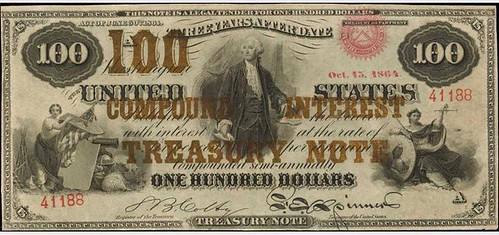
PREV ARTICLE
NEXT ARTICLE
FULL ISSUE
PREV FULL ISSUE
1864 $100 COMPOUND INTEREST TREASURY NOTESo many great rarities have come to market recently that it's easy to get snowblind. In his July 18, 2018 Stacks Bowers blog article, Dave Bowers describes just one of the highlights of the Joel R. Anderson Collection being offered at next month's ANA sale. It is the best of only 13 known surviving examples of the 1864 $100 Compound Interest Treasury Note. -Editor

When it comes to descriptions of the over 200 large-size note types in the Joel R. Anderson Collection, “rare is common” so to speak. In no other auction of currency in American numismatic history has a collection had a higher average rarity and value! Starting years ago Mr. Anderson, who had been in numismatics since a teenager in the early 1960s and who had achieved business success, determined to obtain the finest quality example he could find of the large-size federal currency designs from 1861 to 1928. He set record after record, outbidding the competition to win rarities in the auction offerings of collections, including the first million-dollar note in world auction history (the $100 “Grand Watermelon Note”). Earlier this year, in retirement age but still active, he tapped Stack’s Bowers Galleries to auction his collection. We are doing this in four parts. The first was held in March at the Whitman Coin & Collectibles Expo in Baltimore and set many new records. The second will be a highlight of the World’ Fair of Money to be held in Philadelphia next month. One of the great rarities coming up for sale is the marvelous note described below (from our catalog): Finest Known Fr. 193b $100 Compound Interest Treasury Note Friedberg 193b (Whitman-3390). 1864 $100 Compound Interest Treasury Note. PCGS Currency Extremely Fine 40. It has been nearly a dozen years since an example of this rare $100 Compound Interest Treasury Note was publicly offered. Just 13 examples of this Fr. 193b (W-3390) are known to exist and this serial number 41188 example is the finest by quite a margin. The design type depicts Washington standing at center with allegorical depictions of The Guardian at left and Justice at right. Large 100 protectors are seen at top left and right while the engraved signatures of Colby and Spinner are seen near bottom center. A small red spiked Treasury Seal is at top right with the issue date of Oct. 15, 1864 below. Ideal bronzing is seen on this example with a large 100 in the upper left and COMPOUND INTEREST TREASURY NOTE across the center. The intricate back design features large 100 counters at left and right with interest information at center. Any signs of circulation are light, as this example likely spent much time tucked away in anticipation of redemption which fortunately never occurred. Most of the handling is relegated to the edges and corners. The paper is still bright and free of any distracting marks or obvious impairments. PCGS mentions “Edge Restorations” on the back of the holder. Any such restoration work is deftly executed and difficult to detect even under close scrutiny. Of the 13 examples of this catalog number known, most are recorded as Fine or Very Fine, with one of those residing in the National Numismatic Collection at the Smithsonian Institution. Three others are listed as Poor or Good. This is the lone note graded above Very Fine, long reported as Extremely Fine and now assigned a numeric grade of 40 by PCGS. It last sold publicly in an October 2005 auction for $66,125. Collector interest in these “middle of the (Friedberg) book” notes has been much stronger in recent years and we would not be surprised to see a realization that exceeds the high end of our estimate when our auctioneer cries “Sold!” for this wonderful piece. In actuality, the early issue should be at the front of the book, but cataloging has become more sophisticated since its first edition, and changing numbers is not easy to do. When the Friedberg book was released in 1953 it revolutionized the collecting of federal currency issued from 1861 onward.
$100 Compound Interest Treasury Notes of 1864
To read the complete article, see:
To read the complete lot description, see:

Wayne Homren, Editor The Numismatic Bibliomania Society is a non-profit organization promoting numismatic literature. See our web site at coinbooks.org. To submit items for publication in The E-Sylum, write to the Editor at this address: whomren@gmail.com To subscribe go to: https://my.binhost.com/lists/listinfo/esylum All Rights Reserved. NBS Home Page Contact the NBS webmaster 
|